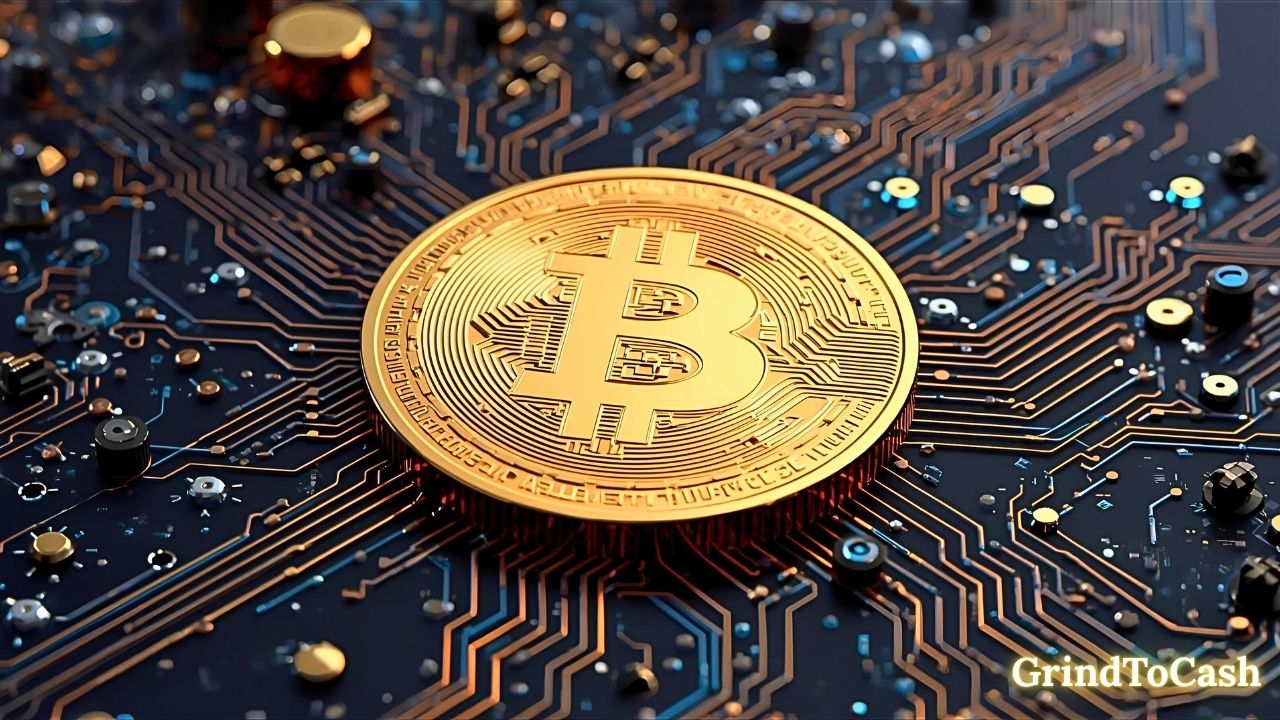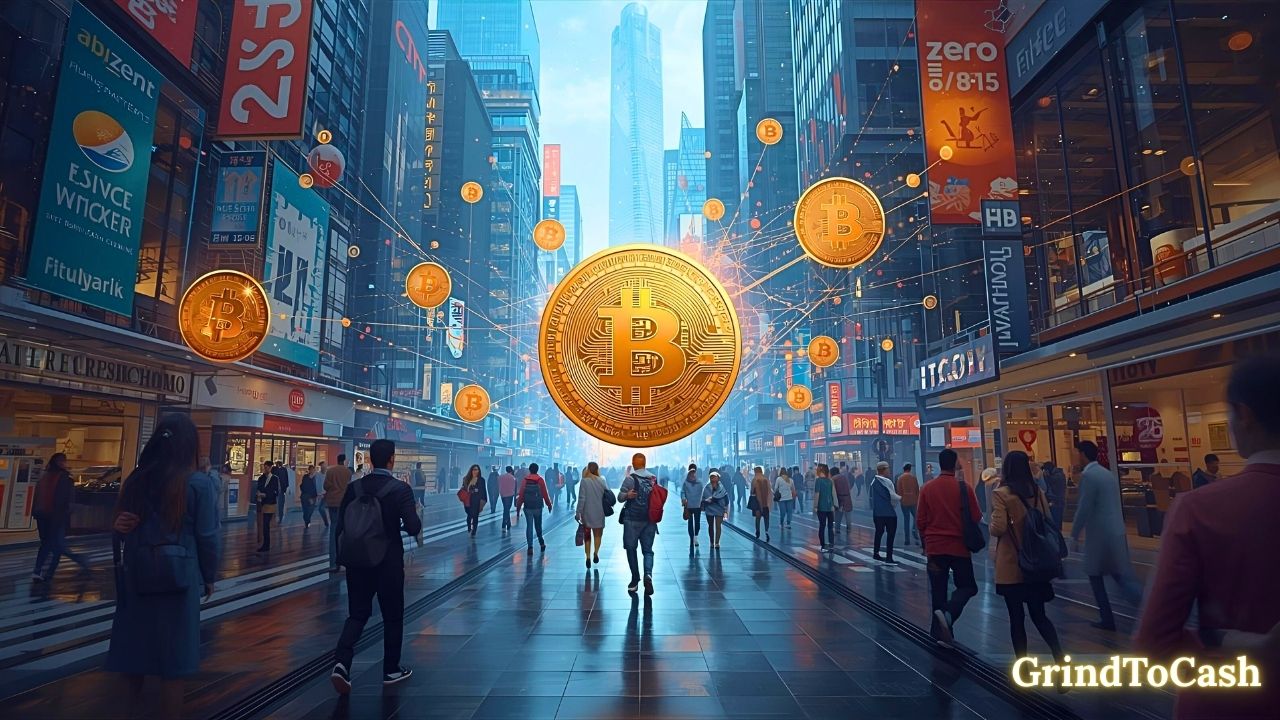Bitcoin’s Rise & Risks in 2025: Complete Guide for Investors
Explore Bitcoin’s journey from its creation to modern-day dominance. Learn about its history, strengths, challenges, and future outlook in 2025—exclusive guide by GrindToCash.
By Yaser | Published on September 13, 2025

The Origins & Early History of Bitcoin
Bitcoin started in 2009 by Satoshi Nakamoto, introduced as a decentralized digital currency to bypass traditional financial systems. It captured attention with its peer-to-peer model, cryptographic security, and fixed supply of 21 million coins. Early adopters saw rapid growth and wild volatility, but those foundational years shaped Bitcoin’s reputation as the gold standard of crypto. GrindToCash considers these early roots essential for any investor to understand its current value.
Creation by Satoshi Nakamoto
Nobody knows for sure who Nakamoto is, but that identity launched an idea that changed finance forever. Bitcoin’s whitepaper introduced decentralized proof-of-work protocol, mining, and the concept of blockchain ledger—all still central to its system.
Initial Growth & Major Milestones
Bitcoin’s first few years saw small adoption, then major breakthroughs: the first real transaction (pizza), exchange listings, and early investor interest. These moments built public trust and drove its early price rises.
Early Challenges & Volatility
Bitcoin’s journey was rocky—price crashes, regulatory confusion, and security breaches. Yet each issue forced improvements in wallets, exchanges, and governance structures that make Bitcoin stronger today.

Bitcoin in Modern Markets – Institutional Adoption & Price Dynamics
In 2025, Bitcoin is no longer just a hobby coin—it’s firmly in finance. Institutions, banks, and ETF products are embracing it as a store of value and inflation hedge. Market behavior shows high volatility, but also rising demand from institutional investors and geopolitical movements. At GrindToCash, we analyze charts, regulatory shifts, and expert voices to give you a clear picture of what powers Bitcoin’s current price action.
Role of ETFs & Institutional Investments
ETFs like spot Bitcoin funds and large corporations buying BTC are driving liquidity and credibility. Demand is rising in regulated channels, signaling that Bitcoin is maturing as an investment instrument.
Recent Price History & Forecasts
Bitcoin saw highs near $109,000 in Q1 2025, followed by pullbacks due to macroeconomic uncertainty. Analysts now expect modest gains through Q4, depending largely on inflation, regulation, and supply dynamics.
Correlation with Markets & Risk Sensitivity
Bitcoin’s price is increasingly correlated with equity markets like the Nasdaq and S&P, magnifying its sensitivity to global economic factors. This means BTC is no longer insulated—it reacts to interest rates, inflation, and major policy news.

Strengths That Make Bitcoin Unique Today
Bitcoin’s network, brand recognition, and scarcity give it advantages few assets hold. Miners, node operators, and open-source developers continuously contribute to its robustness. For investors, these strengths offer confidence. At GrindToCash, we see Bitcoin’s security, decentralization, and increasing regulatory clarity as pillars that uphold its long-term value.
Scarcity & Fixed Supply
With only 21 million bitcoins ever to be mined, Bitcoin’s design creates supply pressure. As demand grows—from retail, institutions, or governments—limited supply supports potential value increase.
Network Security & Decentralization
Bitcoin’s blockchain is secured by proof-of-work across thousands of nodes globally. Developer updates (like upgrades to consensus or scaling solutions) and community governance maintain decentralization and trust.
Recognizable Brand & Acceptance
Bitcoin is accepted by merchants, investment funds, and regulators globally. It acts as a standard measure in crypto discussions and often leads market sentiment. This recognition makes investor trust stronger over time.

Key Challenges & Risks Facing Bitcoin
Despite its dominance, Bitcoin has weaknesses investors must understand. Regulatory uncertainty, energy debate, scaling bottlenecks, and competition from newer chains are real issues. GrindToCash believes that knowing these risks protects you from emotional decisions and steep losses.
Regulatory Pressure & Legal Risks
Governments worldwide debate Bitcoin’s legal status, taxation, and whether it counts as currency or asset. New regulations can affect holding, trading, or use within payments ecosystems.
Environmental & Energy Concerns
The proof-of-work mechanism consumes large energy. Critics point to carbon emissions and sustainability issues. Though there are efforts toward greener mining, energy concerns remain a major debate.
Competition & Technological Innovation
Other blockchains with proof-of-stake, lower fees, or smart contract abilities aim to compete. Bitcoin’s slower upgrade path and feature limitations mean it must rely on its security and network effect more than rapid innovation.

The Developers & Protocol Upgrades
Bitcoin’s strength depends on its developer community and protocol improvements. From scaling solutions to soft forks, developers aim to keep Bitcoin secure while gradually upgrading its performance. At GrindToCash we monitor major proposals, implementation delays, and the impact of upgrades on network usability.
Scaling Efforts & Layer 2 Protocols
Solutions like Lightning Network improve transaction speed and reduce fees off-chain. These layer-2 protocols help Bitcoin scale without compromising the base chain’s security.
Soft Forks & Consensus Changes
Bitcoin’s past includes forks like SegWit and Taproot—each improved privacy or transaction efficiency. Future soft forks may enhance smart contract support or signature schemes.
Community Governance & Key Contributors
Although Bitcoin has no central authority, developers, miners, and influential community members shape its direction. Their debates over scaling, decentralization, and upgrades determine future strength.

Bitcoin’s Real-World Use Cases & Applications
Beyond trading and investing, Bitcoin is used in remittances, digital gold, payment rails, and stores of value. Its use during economic uncertainty and as a hedge defines part of its appeal. GrindToCash believes understanding these applications helps investors see value beyond price charts.
Digital Gold & Store of Value
Many view Bitcoin like gold—limited supply, hedge against inflation, currency collapse, or economic crisis. Its value holds when trust falters in fiat systems.
Remittances & Cross-Border Transactions
Bitcoin’s global reach allows peer-to-peer transfers across borders with fewer intermediaries and fees. For many in regions with unstable currencies, BTC offers financial inclusion.
Payment Acceptance & Merchant Adoption
Major companies and platforms increasingly accept Bitcoin as payment. Infrastructure such as wallets, QR payments, and merchant tools support usage in everyday commerce.

Price Predictions: What Experts Expect
Bitcoin’s price forecasts for late 2025 and beyond vary but show cautious optimism. Experts point to macro trends, ETF demand, supply pressure, and historical cycles. At GrindToCash, we examine predictions critically, comparing multiple sources to present realistic scenarios, not hype.
Near-Term Forecasts (2025)
Some analysts expect Bitcoin to revisit highs near $120,000, particularly if regulatory developments favor institutional investment and ETF inflows continue. Short-term volatility remains high though.
Longer Horizon & Halving Effects
Bitcoin’s next halving event (reward for miners cut in half) typically influences price positively. Long-term predictions consider scarcity and historical halving cycles as tailwinds.
Bear Case Scenarios
Downside risks include regulatory crackdowns, high interest rates, and geoeconomic instability. These factors could suppress growth or trigger corrections.

The Future Outlook & Investor Summary
Bitcoin’s trajectory suggests it will remain a leading asset in digital finance. Institutional adoption, regulatory clarity, and protocol improvements all support a bullish long-term case. GrindToCash recommends investors consider Bitcoin as part of a diversified portfolio, being mindful of risks while leveraging opportunities.
Key Insights for New Investors
If you are new, start small, use trusted wallets and exchanges, and follow the official development roadmap. Having patience gives you advantage over impulsive trades.
How to Position Strategically
Watch for ETF expansions, institutional announcements, and legal developments. These often create momentum. Also monitor tech upgrades that enhance speed, cost, and usability.
Final Thoughts & Recommendations
Bitcoin is not perfect, but its resilience over 16 years proves its staying power. For long-term investors, its combination of scarcity, adoption, and improvements make it a top asset to hold with proper risk allocation.
Conclusion
Bitcoin remains the benchmark for all cryptocurrencies. From its mysterious beginnings to its role in institutional portfolios today, it has forged trust and value that newer projects aspire to reach. While risks and uncertainties persist, those who approach Bitcoin with a clear understanding and smart strategy—as GrindToCash teaches—are more likely to thrive in the evolving world of crypto.









